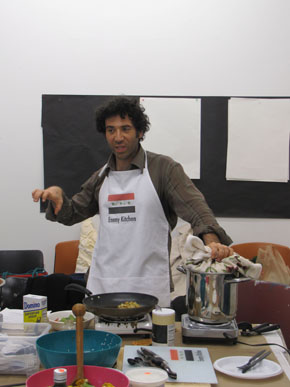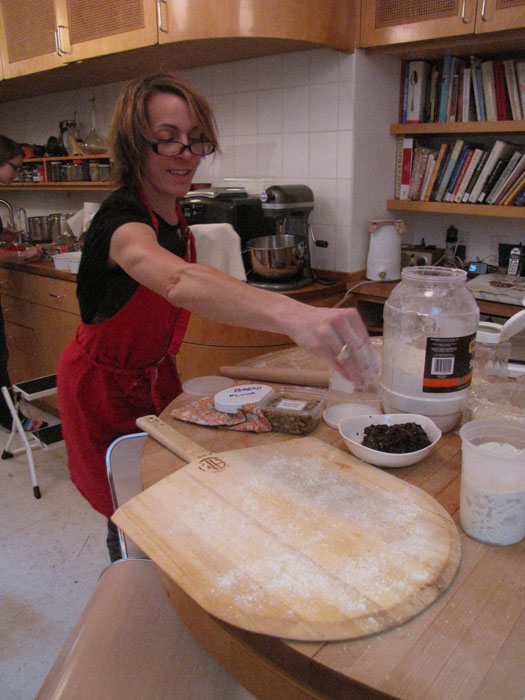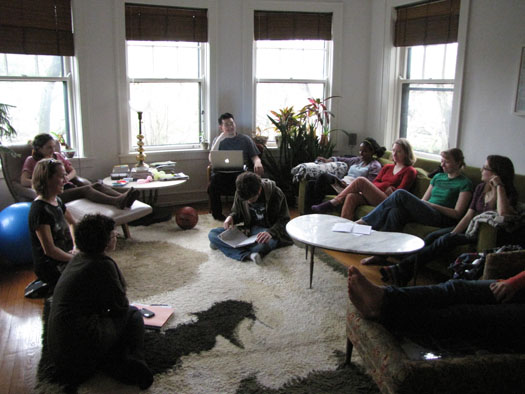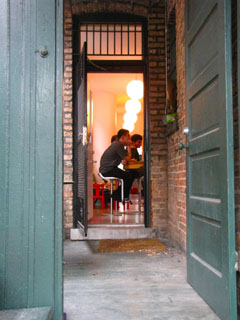Recently in Food for Thought Category
 The studio and classroom spaces of the historic Lorado Taft building of the University of Chicago's Midway Studios are like attics in an old house. They are lofted and beamed, and in this transitional year as the department prepares to move into the Logan Arts Center, piles of supplies and debris stand both as monuments to the logistics of moving, and, last spring, of classes preparing for finals. Stacks of paper covered surfaces, corners of rooms cluttered with charcoal, wire, and foam; underneath a staircase was a neat pile of deconstructed electrical appliances. In another incarnation, the room where Stephanie and Laura's Food for Thought class met last spring could have been a Victorian sitting room, with bay window and lavender-painted molding. As is, a couple of tables pushed together take up most of the room, and on the day of Michael Rakowitz's visit, these were taken over by ingredients: peppers, onions, bags of lentils and rice, bottles of oil and spices, ground beef, hot plates, and glass cutting boards bearing Michael's Enemy Kitchen logo.
The studio and classroom spaces of the historic Lorado Taft building of the University of Chicago's Midway Studios are like attics in an old house. They are lofted and beamed, and in this transitional year as the department prepares to move into the Logan Arts Center, piles of supplies and debris stand both as monuments to the logistics of moving, and, last spring, of classes preparing for finals. Stacks of paper covered surfaces, corners of rooms cluttered with charcoal, wire, and foam; underneath a staircase was a neat pile of deconstructed electrical appliances. In another incarnation, the room where Stephanie and Laura's Food for Thought class met last spring could have been a Victorian sitting room, with bay window and lavender-painted molding. As is, a couple of tables pushed together take up most of the room, and on the day of Michael Rakowitz's visit, these were taken over by ingredients: peppers, onions, bags of lentils and rice, bottles of oil and spices, ground beef, hot plates, and glass cutting boards bearing Michael's Enemy Kitchen logo.In many ways, the character of Michael's spread matched that of Midway's material sprawl: an idiosyncratic combination of bought and found, hunted, gathered, and on loan, as if part of a work-in-progress. As Michael introduced us to the ingredients and his recipes we prepared together for our lunch, he described how creating a migratory cooking space can also be a rhetorical strategy. Setting up these somewhat impromptu, collaborative cooking sites, as he has in his Enemy Kitchen project, becomes a way to forge an inclusive role for himself as artist, teacher, and cook, as a facilitator: the one who starts bringing all the necessary elements together so that the rest of the experience can unfold. In order to make our lunch, we borrowed pots from one student and a hot plate from another; in between stages we ran bowls down to the nearest sink in the basement bathroom to be washed.
Both in previous iterations of Enemy Kitchen, and in his project for Feast, Michael has been interested in developing a form to reflect the multi-dimensional processes of cultural exchange. His project utilizes the capacities of cooking and eating to foster sites of exchange, while also using them to foreground and refute the general absence of Iraqi cuisine from American consciousness. In this way, Michael's project provokes questions about what we have access to and why or why not: about how to exchange that which we don't seem to be able to exchange. The bought ingredients and borrowed supplies function as he does, as facilitators. In Michael's practice, cooking becomes a means of facilitating another kind of practice: that of recognizing and expressing our embedded relationships to Iraq, to nationality, to family, to media consciousness, and to war. At lunch last spring we talked about Michael's plans for his food truck project for Feast. As those plans become more actualized over the next few weeks and months it will be interesting to see what roles cooking and eating develop, and how the logistics of dealing with Chicago food truck regulations becomes another kind of facilitator.
Stephanie Smith and students of the Food for Thought course convene at the home of professor Laura Letinsky for a meal of grilled octopus, flatbread and souffle. Letinsky later discusses with students the ways in which practices of hospitality allow her to explore new themes in her art. These photos were taken by Stacee Kalmanovsky, Food for Thought TA, during last spring quarter ('11).
 In an ideal world, every class would involve going to your teacher's house for lunch, and, ideally, they would make grilled octopus. Grilled octopus is delicious, but the treat isn't the whole appeal. Our class visit at Laura's served multiple functions. It provided us with a fuller context in which to situate Laura's photography practice, and to think about her use of food in photography to deal with themes of labor and time. It gave us more material for our ongoing discussion of contemporary practice and hospitality. And on a more biographical level, having lunch at Laura's apartment was a lesson in her three-year-old son's penchant for basketball, in her relationship with her cat, and, more generally, in her consideration of the relationships and boundaries between the assemblages she composes for her still lifes, and the things that frame her domestic life.
In an ideal world, every class would involve going to your teacher's house for lunch, and, ideally, they would make grilled octopus. Grilled octopus is delicious, but the treat isn't the whole appeal. Our class visit at Laura's served multiple functions. It provided us with a fuller context in which to situate Laura's photography practice, and to think about her use of food in photography to deal with themes of labor and time. It gave us more material for our ongoing discussion of contemporary practice and hospitality. And on a more biographical level, having lunch at Laura's apartment was a lesson in her three-year-old son's penchant for basketball, in her relationship with her cat, and, more generally, in her consideration of the relationships and boundaries between the assemblages she composes for her still lifes, and the things that frame her domestic life.The conversation at Laura's hinged on details: stories behind chairs or kitchen cabinets or the plates she made, about the decision to pair pistachios with slow-cooked onions on the flatbread she served with the octopus; details about family history and food, and the layered ways in which histories of recipes overlap with histories both of economy and of love. Having previously eaten as a group at Theaster's Dorchester Project, Laura made comparisons between Theaster's and her own approach to bringing people together for meals, and about taking pleasure in providing for people. As Laura's and Theaster's practices exist in different spaces, different milieus, and on different scales, the two also represent different kinds of hosts. At the Dorchester Project too there is a sense of being impressed by the personalities of things--by the bowling alley floor boards and long dining benches, the collections and archives. Their interest has to do with the breadth of resources and contributors essential to the integrity of Theaster's project. By contrast, at Laura's house the overwhelming impression is of the specificity and extent of her own daily aesthetic decisions. Where Theaster's hosting practice seems to be about projections of cultural influence, Laura's is about their internalization. Given the themes of Feast, of the course, and of Laura's practice, many of these moments take place in the kitchen: the ethic articulated by emptying the remains of wine glasses into a growing jar of vinegar on a wooden counter, or the presentation of a large soufflé following a lunch already larger than most of us are used to on a Wednesday.
There is this ideal of eating meals with professors, and of having the opportunity to see where they live, or how they live, because we want to feel that the people we are learning form are also available and receptive to us as people. Witnessing part of Laura's process of negotiating a new form in her practice has been a valuable experience for me. For her project for Feast, Laura has been working out a departure from the specific mode of photography she's been so identified with, looking to reflect on themes such as accessibility and generosity, which have long been present in her work, and to engage them from a different angle. Hosting us for lunch felt like practice.
These photos from the Food for Thought course were taken by TA Stacee Kalmanovsky during last spring quarter ('11). Eating lunch with professor Laura Letinsky, sharing a meal with Theaster Gates at the Dorchester Project, and making lunch with Michael Rakowitz provided platforms and experiences for the class to delve into many aspects of art, food, and hospitality. The course culminated in the students creating and critiquing food-related projects.

This spring I was lucky to participate in Food for Thought, a class co-taught by Stephanie Smith and Laura Letinsky. The class explored relationships between food culture and contemporary art, utilizing an interdisciplinary framework. We looked at art historical representations of food, mapping the legacy of seventeenth-century still life painting onto modernist interpretations of the still life form, through cubism and Dada, and onto contemporary practices of artists revisiting these motifs, such as Daniel Speorri, and the younger artists he's influenced. The class considered food and eating as both subject and medium for art, but also as its own domain: looking at these intersections as a way to understand broader cultural concerns about production and consumption, sociality and lifestyle. We surveyed readings from social anthropology, and from popular ecologists like Michael Pollan, dealing with interactions between food and fashion: the language of "slow food," "organic," and "foodie," and trends more particular to Chicago's restaurant scene--parsing out what these labels imply about the way we live, and what implications they could have for a social, artistic practice.
A central concern was the relationship between food and performativity in contemporary art, and the different ways in which artists have used food to engage issues of hospitality, generosity, and cultural meaning in their practices. Mirroring the historical and thematic scope of Feast, we looked at the Futurists' project as marking a moment of realization in art, of actively incorporating the meal into a cultural, artistic identity through banquets and manifestos, and using the meal as a medium to give form to major political questions. We related the impulses and images that came out of 1960s-70s performance art both to the form of the Manifesto, and to issues that are getting worked out now among different contemporary art practices, about how to engage socially and critically.
The class was in many ways a collaboration between Laura and Stephanie, and our conversations benefited from their perspectives and experiences as artist and curator. Our small group ranged in academic interests and backgrounds, from first-years in the college to MA students, visual art students to economics students. This collaboration, and the gesture involved in bringing a class of students into the process of conceptualizing Feast, speaks both to the nature of the subject, and to the evolution of the project. The artist visits and meals that took place during the class, with Theaster Gates, Michael Rakowitz, and one with Laura at her apartment, help to illustrate the connections between Food for Thought and Feast, and are central to this conversation.
Continue reading Food for Thought.
 The Feast blog has been dormant for the past year--a calm that belies huge amounts of behind-the-scenes activity as we get ready for the exhibition's opening on February 16, 2012. To share that energy, we're re-launching the site with a bright new look courtesy of Jason Pickleman and JNL graphic design and fresh content by a new group of contributors. We'll pull back the curtain so you can peek into artists' studios and museum archives. We'll highlight classic older art and introduce works-in-progress commissioned especially for Feast. We'll unpack the many kinds of creative labor and collaboration that go into producing a complex exhibition like this one. And we'll look ahead to all the events that will kick off with the exhibition's opening in February and spill out onto campus and around the city until June. Watch for regular posts over the coming months.
The Feast blog has been dormant for the past year--a calm that belies huge amounts of behind-the-scenes activity as we get ready for the exhibition's opening on February 16, 2012. To share that energy, we're re-launching the site with a bright new look courtesy of Jason Pickleman and JNL graphic design and fresh content by a new group of contributors. We'll pull back the curtain so you can peek into artists' studios and museum archives. We'll highlight classic older art and introduce works-in-progress commissioned especially for Feast. We'll unpack the many kinds of creative labor and collaboration that go into producing a complex exhibition like this one. And we'll look ahead to all the events that will kick off with the exhibition's opening in February and spill out onto campus and around the city until June. Watch for regular posts over the coming months.
Ace intern Sarah Mendelsohn will lead off with posts about her participation in Food for Thought, a University of Chicago class that that Professor Laura Letinsky and I co-taught during spring quarter 2011. Laura is one of the artists featured in Feast, and we designed the course to go beyond the meal--Feast's focus--to address the broader topic of food in art. Food and its consumption form essential parts of human experience and have played a correspondingly rich role within creative cultural production over millennia--as vehicles for need and desire, purity and danger, value and lack, connection and disruption. The course considered what's at stake when contemporary artists build on this longstanding practice to explore the complexities of current societal, political, and cultural contexts.
One especially satisfying part of the course were workshops and field trips in which we prepared and shared meals together as a way to ground theoretical debates. For three of these sessions, exhibiting artists Theaster Gates, Laura Letinksy, and Michael Rakowitz met with the class to discuss their approach to artmaking and share works-in-progress for Feast. Food for Thought followed a long tradition of connecting the Smart to University teaching--from Art 101 sessions focused on objects in the collection to seminars like this one that give students intimate views into the working processes of contemporary artists. (Any current UofC students reading this: note that a revised version of the course will be offered in Spring 2012, while Feast is on view. Sign up early. Tell your friends!) More soon on the course and workshops from Sarah.